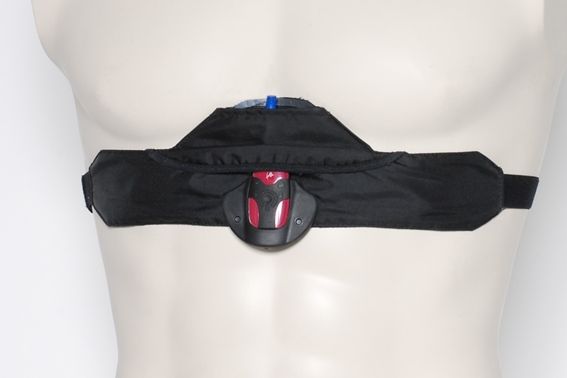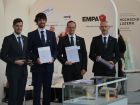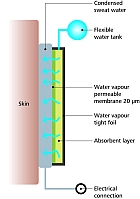| |
| The prototype chest strap ECG-monitor has been tested in over hundred experiments on male and female subjects |
| |
| The demand for ECG monitoring systems is increasing, and not just because hospitals and rehabilitation clinics are interested in such instruments for the long-term monitoring of patients’ hearts and circulatory systems. In addition, the trend towards recording and collecting personal health data is booming. To date, however, a major hurdle has been the fact that gel electrodes have been necessary for reliable long-term ECG measurements, but these dry out within 24 hours after which they no longer produce usable signals. They are also not very suitable for older patients who frequently sweat less and are less mobile than younger subjects |
| |
| The idea of developing wettable electrodes for an ECG monitor germinated during a project to develop cooling garments for multiple sclerosis patients, in which an Empa team collaborated with industrial partners. The pain relieving cooling effect was generated by the material continuously allowing minimal quantities of water to permeate through it. The same technology is perfectly suited to keeping heart monitor electrodes moist all the time. |
| |
Artificial sweat from the «reservoir»
In order for the metallized sensors to detect and transmit signals from the body in a reliable and stable manner, the space between the electrode and the skin must be kept slightly moist. This is akin to the human sweating process without the cooling effect, and is maintained at such a minimal level that the wearer of the chest strap does not notice the moistening process at all. In order to create this effect a team from Empa’s «Protection and Physiology» laboratory, in a project financially supported by the Swiss Commission for Technology and Innovation (CTI), developed flexible wetting elements. These are filled with 30 mL of water and they then ensure that the skin of the wearer is kept permanently moist. The «reservoir» is a hollow space between a watertight membrane and a textile layer which is permeable to water vapour. Instead of sewing these together, the Empa scientists weld them to each other using a special laser technique which they have perfected. The resulting laser-welded seams are impervious to water and water vapour. The reservoir continually supplies minute quantities of water vapour to keep electrodes moist, lasting for at least five days before needing a refill. |
| |
|
| |
| | | Empa's award winning team of Textile Innovation Award 2015. From left to right: Michel Schmid, Alexander Haag, René Rossi, Rudolf Hufenus. |
| |
|
| |
Nanometer thin plasma coating
In this way the electrode pads, which are interleaved with a special fiber, are kept moist. The electrodes are capable not only of acquiring the wearer’s heart signals but also all the other bodily signals which are necessary for cardiological analysis. The interleaved fiber is made of polyethylene terephthalate (PET) and is given a special plasma coating by scientists from Empa’s «Advanced Fibers» laboratory using equipment developed by them. The coating on the fiber is extremely thin, a mere 100nm or so, and consists of two layers. An inner layer of silver serves to conduct the electrical signals and prevent the growth of microorganisms, while the outer layer of titanium, just a few nanometers thick, ensures signal stability and prevents skin irritation occurring and the release of silver particles. |
| |
Stringent conditions for ECG monitors
Each chest strap contains two of the specially prepared sensor pads which are connected directly to a data logger. The recorded signals are transmitted on to a central data collection unit or a standard monitoring device. The data logger is attached with snap fasteners so it can be removed in order for the belt to be washed – one of the stringent conditions which the system had to fulfil before it was authorized for use in long-term ECG monitoring for medical purposes |
| |
|
| |
| | | Function diagram: Thanks to a water reservoir, the electrode always remains moist and yields reliable data |
| |
|
| |
| The device has already been tested in the course of over 100 experiments with volunteer subjects. It will, however, be some time before the system is available on the market since the project is still in the prototype phase. The next step is the start of clinical tests as part of a CTI follow-on project together with the University Hospital, Basel, and various industrial partners – Unico Swiss Tex GmbH, Forster Rohner, Serge Ferrari SA, xotox and Zietromec. And even now, Empa researchers are considering where else these special electrodes might find uses. Possible examples are in muscle stimulation for pain alleviation, and interference wave therapy to reactivate colon function in bedridden patients. |
| |
The jury of the «Techtextil Innovation Awards 2015» was obviously convinced that Empa’s new chest strap ECG monitor has great potential, for in recognition of this they rewarded the project with the coveted Techtextil Innovation Award in the «New Product» category. “Because,” according to the laudation, “the embroidered electrode used for long term ECG monitoring caters to the growing demand for medical applications which take advantage of textile based materials.”
The prize certificate was presented to the project team on May 4th 2015 during Techtextil, the leading International Trade Fair for Technical Textiles and Nonwovens, held this year in Frankfurt am Main, Germany. |
| |
| |
| |
| Images can be downloaded here. |
| |
| |




